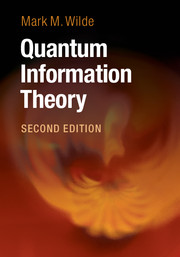Book contents
- Frontmatter
- Contents
- Preface to the Second Edition
- Preface to the First Edition
- How To Use This Book
- Part I Introduction
- Part II The Quantum Theory
- Part III Unit Quantum Protocols
- Part IV Tools of Quantum Shannon Theory
- Part V Noiseless Quantum Shannon Theory
- Part VI Noisy Quantum Shannon Theory
- Appendix A Supplementary Results
- Appendix B Unique Linear Extension of a Quantum Physical Evolution
- References
- Index
Preface to the First Edition
Published online by Cambridge University Press: 16 February 2017
- Frontmatter
- Contents
- Preface to the Second Edition
- Preface to the First Edition
- How To Use This Book
- Part I Introduction
- Part II The Quantum Theory
- Part III Unit Quantum Protocols
- Part IV Tools of Quantum Shannon Theory
- Part V Noiseless Quantum Shannon Theory
- Part VI Noisy Quantum Shannon Theory
- Appendix A Supplementary Results
- Appendix B Unique Linear Extension of a Quantum Physical Evolution
- References
- Index
Summary
I began working on this book in the summer of 2008 in Los Angeles, with much time to spare in the final months of dissertation writing. I had a strong determination to review quantum Shannon theory, a beautiful area of quantum information science that Igor Devetak had taught me three years earlier at USC in fall 2005. I was carefully studying a manuscript entitled “Principles of Quantum Information Theory,” a text that Igor had initiated in collaboration with Patrick Hayden and Andreas Winter. I read this manuscript many times, and many parts of it I understood well, though other parts I did not.
After a few weeks of reading and rereading, I decided “if I can write it out myself from scratch, perhaps I would then understand it!”, and thus began the writing of the chapters on the packing lemma, the covering lemma, and quantum typicality. I knew that Igor's (now former) students Min-Hsiu Hsieh and Zhicheng Luo knew the topic well because they had already written several quality research papers with him, so I requested if they could meet with me weekly for an hour to review the fundamentals. They kindly agreed and helped me quite a bit in understanding the packing and covering techniques.
After graduating, I began collaborating with Min-Hsiu on a research project that Igor had suggested to the both of us: “find the triple trade-off capacity formulas of a quantum channel.” This was perhaps the best starting point for me to learn quantum Shannon theory because proving this theorem required an understanding of most everything that had already been accomplished in the area. After a month of effort, I continued to work with Min-Hsiu on this project while joining Andreas Winter's Singapore group for a two-month visit. As I learned more, I added more to the notes, and they continued to grow.
After landing a job in the DC area for January 2009, I realized that I had almost enough material for teaching a course, and so I contacted local universities in the area to see if they would be interested. Can Korman, formerly chair of the Electrical Engineering Department at GeorgeWashington University, was excited about the possibility.
- Type
- Chapter
- Information
- Quantum Information Theory , pp. xiii - xivPublisher: Cambridge University PressPrint publication year: 2017



